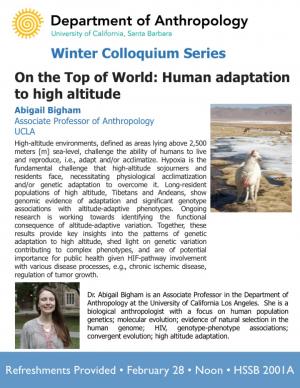Event Date:
Friday, February 28, 2020 - 12:00pm to 1:00pm
Event Location:
- HSSB 2001A
High-altitude environments, defined as areas lying above 2,500 meters [m] sea-level, challenge the ability of humans to live and reproduce, i.e., adapt and/or acclimatize. Hypoxia is the fundamental challenge that high-altitude sojourners and residents face, necessitating physiological acclimatization and/or genetic adaptation to overcome it. Long-resident populations of high altitude, Tibetans and Andeans, show genomic evidence of adaptation and significant genotype associations with altitude-adaptive phenotypes. Ongoing research is working towards identifying the functional consequence of altitude-adaptive variation. Together, these results provide key insights into the patterns of genetic adaptation to high altitude, shed light on genetic variation contributing to complex phenotypes, and are of potential importance for public health given HIF-pathway involvement with various disease processes, e.g., chronic ischemic disease, regulation of tumor growth.
January 30, 2020 - 3:06pm




